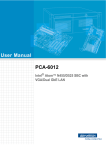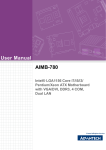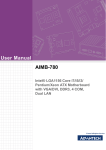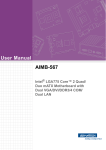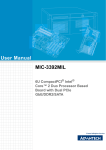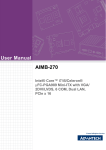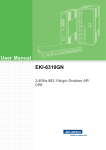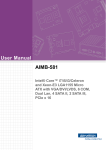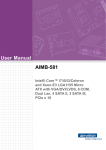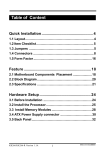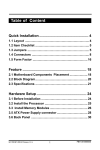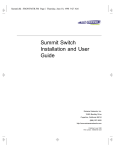Download Advantech PCA-684 User manual
Transcript
User Manual PCA-6011 PICMG 1.0 Full-sized Intel® LGA775 Core™2 Quad CPU Card with VGA/Dual GbE LAN Copyright The documentation and the software included with this product are copyright 2011 by Advantech Co., Ltd. All rights are reserved. Advantech Co., Ltd. reserves the right to make improvements in the products described in this manual at any time without notice. No part of this manual may be reproduced, copied, translated or transmitted in any form or by any means without the prior written permission of Advantech Co., Ltd. Information provided in this manual is intended to be accurate and reliable. However, Advantech Co., Ltd. assumes no responsibility for its use, nor for any infringements of the rights of third parties, which may result from its use. Acknowledgements AMI is a trademark of American Megatrends Inc. IBM and PC are trademarks of International Business Machines Corporation. Intel® CoreTM 2 Quad, Core™ 2 Duo, and Celeron® are trademarks of Intel Corporation. WinBond is a trademark of Winbond Corporation. All other product names or trademarks are the properties of their respective owners. PCA-6011 User Manual Part No. 2002601100 Edition 1 Printed in China April 2011 ii A Message to the Customer Advantech Customer Services Each and every Advantech product is built to the most exacting specifications to ensure reliable performance in the harsh and demanding conditions typical of industrial environments. Whether your new Advantech equipment is destined for the laboratory or the factory floor, you can be assured that your product will provide the reliability and ease of operation for which the name Advantech has come to be known. Your satisfaction is our primary concern. Here is a guide to Advantech’s customer services. To ensure you get the full benefit of our services, please follow the instructions below carefully. Technical Support We want you to get the maximum performance from your products. So if you run into technical difficulties, we are here to help. For the most frequently asked questions, you can easily find answers in your product documentation. These answers are normally a lot more detailed than the ones we can give over the phone. So please consult this manual first. If you still cannot find the answer, gather all the information or questions that apply to your problem, and with the product close at hand, call your dealer. Our dealers are well trained and ready to give you the support you need to get the most from your Advantech products. In fact, most problems reported are minor and are able to be easily solved over the phone. In addition, free technical support is available from Advantech engineers every business day. We are always ready to give advice on application requirements or specific information on the installation and operation of any of our products. Declaration of Conformity FCC Class A Note: This equipment has been tested and found to comply with the limits for a Class A digital device, pursuant to part 15 of the FCC Rules. These limits are designed to provide reasonable protection against harmful interference when the equipment is operated in a commercial environment. This equipment generates, uses, and can radiate radio frequency energy and, if not installed and used in accordance with the instruction manual, may cause harmful interference to radio communications. Operation of this equipment in a residential area is likely to cause harmful interference in which case the user will be required to correct the interference at his own expense. Caution! There is a danger of a new battery exploding if it is incorrectly installed. Do not attempt to recharge, force open, or heat the battery. Replace the battery only with the same or equivalent type recommended by the manufacturer. Discard used batteries according to the manufacturer’s instructions. iii PCA-6011 User Manual Memory Compatibility Brand Size Speed Type Memory Advantech PN 1GB 1066 DDR3 SEC K4B1G0846D-HCF8 (128x8) 96D3-1G1066NNTR Transcend 1GB 1066 DDR3 SEC K4B1G0846D HCH9 ENJ038A3 (128x8) 96D3-1G1066NNTR 2GB 1066 DDR3 SEC K4B1G0846D-HCF9(128x8) 96D3-2G1066NNTR 1GB 1066 DDR3 ELPIDA J1108BABG-AE-E (128x8) 96D3-1G1066NNAP 1GB 1066 DDR3 ELPIDA J1108BABG-DJ-E (128x8) 96D3-1G1066NNAP 2GB 1066 DDR3 ELPIDA J1108BABG-AE-E (128x8) 96D3-2G1066NNAP 2GB 1066 DDR3 ELPIDA J1108BABG-DJ-E 092109D1P (128x8) 96D3-2G1066NNAP 4GB 1066 DDR3 Hynix H5TQ2G83AFR H9C (256x8) NA 4GB 1066 DDR3 SAMSUNG 940 K4B2G0846BHCF8 (256x8) 96D3-4G1066NNAP Apacer ATP Specification Comparison Part Number LAN PCA-6011VG-00A1E PCA-6011G2-00A1E VGA COM SATA USB DVI Single GbE Yes 2 4 8 No (Optional) No (Optional) Dual GbE 2 4 7 No (Optional) No (Optional) Yes Processor Support Processors Long-life supported Intel® CoreTM 2 Quad processor Q9400 TM 2 Intel® Core Duo processor E8400/E7400/ E6400/ E4300 Intel® Pentium® processor E5300 Intel Celeron processor 440 Celeron 440 PCA-6011 User Manual iv CF Product Warranty (2 years) Advantech warrants to you, the original purchaser, that each of its products will be free from defects in materials and workmanship for two years from the date of purchase. This warranty does not apply to any products which have been repaired or altered by persons other than repair personnel authorized by Advantech, or which have been subject to misuse, abuse, accident or improper installation. Advantech assumes no liability under the terms of this warranty as a consequence of such events. Because of Advantech’s high quality-control standards and rigorous testing, most of our customers never need to use our repair service. If an Advantech product is defective, it will be repaired or replaced at no charge during the warranty period. For outof-warranty repairs, you will be billed according to the cost of replacement materials, service time and freight. Please consult your dealer for more details. If you think you have a defective product, follow these steps: 1. Collect all the information about the problem encountered. (For example, CPU speed, Advantech products used, other hardware and software used, etc.) Note anything abnormal and list any onscreen messages you get when the problem occurs. 2. Call your dealer and describe the problem. Please have your manual, product, and any helpful information readily available. 3. If your product is diagnosed as defective, obtain an RMA (return merchandise authorization) number from your dealer. This allows us to process your return more quickly. 4. Carefully pack the defective product, a fully-completed Repair and Replacement Order Card and a photocopy proof of purchase date (such as your sales receipt) in a shippable container. A product returned without proof of the purchase date is not eligible for warranty service. 5. Write the RMA number visibly on the outside of the package and ship it prepaid to your dealer. v PCA-6011 User Manual Initial Inspection Before you begin installing your single board computer, please make sure that the following materials have been shipped: PCA-6011 Intel® LGA775 processor-based single board computer 1 PCA-6011 startup manual 1 CD with driver utility and manual (in PDF format) 1 Ultra ATA 66/100 IDE cable 2 Serial ATA HDD data cable 2 Serial ATA HDD power cable 1 Printer (parallel) port & COM port cable kit 1 Y cable for PS/2 keyboard and PS/2 mouse 1 USB cable with 4 ports 1 Jumper pack 1 User Note for Full-Size CPU card 1 User Note for LGA775 CPU 1 warranty card P/N: 1701400452 P/N: 1700003194 P/N: 1703150102 P/N: 1701260305 P/N: 1700060202 P/N: 1700008461 P/N: 9689000068 P/N: 2002721020 If any of these items are missing or damaged, contact your distributor or sales representative immediately. We have carefully inspected the PCA-6011 mechanically and electrically before shipment. It should be free of marks and scratches and in perfect working order upon receipt. As you unpack the PCA-6011, check it for signs of shipping damage. (For example, damaged box, scratches, dents, etc.) If it is damaged or it fails to meet the specifications, notify our service department or your local sales representative immediately. Also notify the carrier. Retain the shipping carton and packing material for inspection by the carrier. After inspection, we will make arrangements to repair or replace the unit. Note! PCA-6011 must use a proprietary CPU cooler; we strongly recommend purchasing it from Advantech (p/n: 1750000332). PCA-6011 User Manual vi Contents Chapter 1 Hardware Configuration......................1 1.1 1.2 1.3 1.14 Introduction ............................................................................................... 2 Features .................................................................................................... 2 Specifications ............................................................................................ 3 1.3.1 System .......................................................................................... 3 1.3.2 Memory ......................................................................................... 3 1.3.3 Input/Output .................................................................................. 3 1.3.4 Ethernet LAN ................................................................................ 3 1.3.5 Industrial features ......................................................................... 3 1.3.6 Mechanical and environmental specifications............................... 4 Jumpers and Connectors .......................................................................... 4 Table 1.1: Jumpers...................................................................... 4 Table 1.2: Connectors ................................................................. 5 Board Layout: Jumper and Connector Locations...................................... 6 Figure 1.1 Jumper and Connector locations................................ 6 PCA-6011 Block Diagram ......................................................................... 7 Figure 1.2 PCA-6011 Block Diagram........................................... 7 Safety Precautions .................................................................................... 8 Jumper Settings ........................................................................................ 8 1.8.1 How to set jumpers ....................................................................... 8 1.8.2 CMOS clear (CMOS1) .................................................................. 8 Table 1.3: CMOS (CMOS1)......................................................... 9 1.8.3 Watchdog timer output (JWDT1) .................................................. 9 Table 1.4: Watchdog timer output (JWDT1) ................................ 9 System Memory ........................................................................................ 9 1.9.1 CPU FSB and memory speed....................................................... 9 Memory Installation Procedures................................................................ 9 Cache Memory........................................................................................ 10 Processor Installation.............................................................................. 10 Power Model Setting and Installation...................................................... 11 1.13.1 AT Mode ..................................................................................... 11 ATX Mode ............................................................................................... 13 2 Connecting Peripherals ....................15 2.1 2.2 2.3 2.4 2.5 2.6 2.7 2.8 2.9 2.10 Introduction ............................................................................................. 16 IDE Connectors (IDE1) ........................................................................... 16 Floppy Drive Connector (FDD1).............................................................. 17 Parallel Port (LPT1)................................................................................. 17 VGA Connector (VGA1) .......................................................................... 18 Serial Ports (COM1, COM2) ................................................................... 18 PS/2 Keyboard and Mouse Connector (KBMS1) .................................... 19 External Keyboard & Mouse (KBMS2).................................................... 19 CPU Fan Connector (CPUFAN1)............................................................ 20 Front Panel Connectors (JFP1, JFP2, JFP3).......................................... 20 2.10.1 ATX soft power switch (JFP1 / PWR_SW) ................................. 20 2.10.2 Reset (JFP1 / RESET)................................................................ 21 2.10.3 HDD LED (JFP2 / HDDLED)....................................................... 21 2.10.4 SMBus Connector (JFP2 / SNMP).............................................. 21 2.10.5 External speaker (JFP2 / SPEAKER) ......................................... 21 2.10.6 Power LED and keyboard lock connector (JFP3 / PWR_LED&KEY LOCK) ......................................................................................... 21 Table 2.1: ATX Power Supply LED Status (No support for AT Power) ...................................................................... 21 1.4 1.5 1.6 1.7 1.8 1.9 1.10 1.11 1.12 1.13 Chapter vii PCA-6011 User Manual 2.11 2.16 2.17 H/W Monitor Alarm (JOBS1)................................................................... 22 Table 2.2: Hardware Monitor Alarm setting............................... 22 LAN RJ45 connector (LAN1/LAN2) ........................................................ 22 HD Link connector (HDAUD1) ................................................................ 23 Serial ATA2 Interface (SATA1 ~ SATA4)................................................ 23 LAN LED connector (LAN LED1)............................................................ 24 Table 2.3: Front Panel LAN indicator connector ....................... 24 USB (USB12, USB34, USB56, USB78).................................................. 25 Case open (JCASE1).............................................................................. 25 3 AMI BIOS Setup................................. 27 3.1 Introduction ............................................................................................. 28 Figure 3.1 Setup Program Initial Screen ................................... 28 Entering Setup ........................................................................................ 29 3.2.1 Main Setup.................................................................................. 29 Figure 3.2 Main Setup Screen................................................... 29 3.2.2 Advanced BIOS Features Setup................................................. 30 Figure 3.3 Advanced BIOS Features Setup Screen.................. 30 Figure 3.4 CPU Configuration Settings ..................................... 30 Figure 3.5 IDE Configuration ..................................................... 31 Figure 3.6 Super I/O Configuration............................................ 32 Figure 3.7 Hardware Health Configuration ................................ 33 Figure 3.8 APM Configuration ................................................... 34 Figure 3.9 MPS Configuration ................................................... 35 Figure 3.10Smbios Configuration ............................................... 35 3.2.3 PCI/PNP Setup ........................................................................... 37 Figure 3.11PCI/PNP Setup_1..................................................... 37 Figure 3.12PCI/PNP Setup_2..................................................... 37 3.2.4 Boot Settings .............................................................................. 39 Figure 3.13 Boot Settings ........................................................... 39 Figure 3.14Boot Settings Configuration...................................... 39 3.2.5 Security Settings......................................................................... 40 Figure 3.15Security Settings ...................................................... 40 3.2.6 Advanced Chipset Settings......................................................... 41 Figure 3.16Advanced Chipset Settings ...................................... 41 Figure 3.17North Bridge Configuration....................................... 41 Figure 3.18Video Function Configuration ................................... 42 Figure 3.19 South Bridge Chipset Configuration ........................ 43 3.2.7 Exit Options ................................................................................ 44 Figure 3.20Exit Options .............................................................. 44 2.12 2.13 2.14 2.15 Chapter 3.2 Chapter Chapter Chapter 4 Chipset Software Installation Utility 47 4.1 4.2 4.3 Before You Begin.................................................................................... 48 Introduction ............................................................................................. 48 Windows XP Driver Setup....................................................................... 49 5 VGA Setup ......................................... 53 5.1 5.2 5.3 Introduction ............................................................................................. 54 Preparation for VGA Driver Setup........................................................... 54 Windows XP Driver Setup....................................................................... 56 6 LAN Configuration ............................ 59 6.1 Introduction ............................................................................................. 60 PCA-6011 User Manual viii 6.2 6.3 6.4 Features .................................................................................................. 60 Installation ............................................................................................... 60 Win XP Driver Setup ............................................................................... 61 Appendix A Programming the Watchdog Timer..65 A.1 Programming the Watchdog Timer ......................................................... 66 A.1.1 Watchdog timer overview............................................................ 66 A.1.2 Jumper selection......................................................................... 66 A.1.3 Programming the Watchdog Timer ............................................. 66 Table A.1: Watchdog Timer Registers ....................................... 68 A.1.4 Example Program ....................................................................... 69 Appendix B I/O Pin Assignments..........................73 B.1 IDE Hard Drive Connector (IDE1) ........................................................... 74 Table B.1: IDE Hard Drive Connector (IDE1) ............................ 74 Floppy Drive Connector (FDD1).............................................................. 75 Table B.2: Floppy Drive Connector (FDD1) ............................... 75 Parallel Port Connector (LPT1) ............................................................... 76 Table B.3: Parallel Port Connector (LPT1) ................................ 76 VGA Connector (VGA1) .......................................................................... 77 Table B.4: VGA Connector (VGA1) ........................................... 77 RS-232 Serial Port (COM1, COM2) ........................................................ 77 Table B.5: RS-232 Serial Port (COM1, COM2) ......................... 77 PS/2 Keyboard/Mouse Connector (KBMS1) ........................................... 78 Table B.6: PS/2 Keyboard/Mouse Connector (KBMS1) ............ 78 External Keyboard Connector (KBMS2) ................................................. 78 Table B.7: External Keyboard Connector (KBMS2)................... 78 CPU Fan Power Connector (CPUFAN1) ................................................ 79 Table B.8: CPU Fan Power Connector (CPUFAN1).................. 79 Power LED and Keyboard Lock Connector (JFP3 / PWR_LED & KEY LOCK) ..................................................................................................... 79 Table B.9: Power LED and Keyboard Lock Connector (JFP3 / PWR_LED & KEY LOCK)......................................... 79 External Speaker Connector (JFP2 / SPEAKER) ................................... 80 Table B.10:External Speaker Connector (JFP2 / SPEAKER)..... 80 Reset Connector (JFP1 / RESET) .......................................................... 80 Table B.11:Reset Connector (JFP1 / RESET)............................ 80 HDD LED (JFP2 / HDDLED)................................................................... 80 Table B.12:HDD LED (JFP2 / HDDLED) .................................... 80 ATX Soft Power Switch (JFP1 / PWR_SW) ............................................ 81 Table B.13:ATX Soft Power Switch (JFP1 / PWR_SW) ............. 81 SM Bus Connector (JFP2/SNMP).......................................................... 81 Table B.14:SM BUX Connector (JFP2/SNMP) ........................... 81 HD Link connector (HDAUD1) ................................................................ 81 Table B.15:HD Link Connector (HDAUD1) ................................. 81 LAN LED Connector (LAN LED1) ........................................................... 82 Table B.16:LAN LED Connector (LANLED1).............................. 82 AT Power Connector (ATXF1) ................................................................ 82 Table B.17:AT Power Connector (ATXF1).................................. 82 H/W Monitor Alarm (JOBS1) ................................................................... 83 Table B.18:H/W Monitor Alarm (JOBS1) .................................... 83 USB Connector (USB12, USB34, USB56, USB78) ................................ 83 Table B.19:USB Connector (USB12, USB34, USB56, USB78).. 83 Case Open Connector (JCASE1) ........................................................... 83 Table B.20:Case Open Connector (JCASE1)............................. 83 GPIO Pin Header (GPIO1)...................................................................... 84 Table B.21:GPIO Pin Header (GPIO1) ....................................... 84 B.2 B.3 B.4 B.5 B.6 B.7 B.8 B.9 B.10 B.11 B.12 B.13 B.14 B.15 B.16 B.17 B.18 B.19 B.20 B.21 ix PCA-6011 User Manual B.22 B.23 B.24 B.25 B.26 PCA-6011 User Manual System I/O Ports..................................................................................... 84 Table B.22:System I/O Ports ...................................................... 84 DMA Channel Assignments .................................................................... 85 Table B.23:DMA Channel Assignments ..................................... 85 Interrupt Assignments ............................................................................. 85 Table B.24:Interrupt Assignments .............................................. 85 1st MB Memory Map............................................................................... 86 Table B.25:1st MB Memory Map ................................................ 86 PCI Bus Map........................................................................................... 86 Table B.26:PCI Bus Map ............................................................ 86 x Chapter 1 Hardware Configuration 1 1.1 Introduction The PCA-6011 is designed with the Intel® G41 + ICH7/ICH7R (only for G2 SKU) to support Core™ 2 Quad / Core™ 2 Duo /channel 440 processors (refer to “Processor Support” on page v) with a 800/1066/1333 MHz front side bus and dual channel DDR3 800/1066 MHz memory up to 4 GB. It follows the PICMG 1.0 specification and is the best solution for high-performance computing and applications that demand a wide I/O bandwidth. The PCA-6011 offers a high-performance cost-saving integrated graphics unit, built into the Intel® G41 chipset, and features the unique Intel® GMA X4500 technology, including built-in support for smooth high-definition video playback without the need for add-on video cards or decoders. It has 2 DIMM sockets in two separate memory channels. It accepts up to 4 GB DDR3 SDRAM memory--plenty for most applications. The PCA-6011 supports 1 to 2 Gigabit Ethernet LAN via dedicated PCI Express x 1 bus, which offers bandwidths up to 500 MB/sec., eliminating network data flow bottlenecks, and incorporating Gigabit Ethernet to operate at 1000 Mbps. High reliability and outstanding performance make the PCA-6011 the ideal platform for industrial networking applications. Four Serial ATA ports (up to 300 MB/s) allow the use of long, thin SATA cables for storage devices, eliminating cabling issues inside the industrial-grade chassis. In addition, the PCA-6011 also provides most of the popular I/O interfaces including up to eight USB 2.0 ports, 2 RS-232 ports, one enhanced parallel port and a floppy disk interface. The PCA-6011 is designed for extended reliability, and is built especially to suit demanding industrial environments. The CMOS data backup and restore function protects the BIOS setup data from loss due to battery failure. The PCA-6011 also adopts Advantech's unique patented “AT Mode Control Circuit” for AT Power Mode. With all these excellent features and outstanding performance, the PCA-6011 is definitely an ideal platform for today's industrial applications. 1.2 Features Compliance with PICMG 1.0 Supports LGA 775 Intel® Core™ 2 Quad / Core™ 2 Duo/Celeron® 440 FSB 800/1066/1333 MHz processors (refer to “Processor Support” on page iv) Supports Dual Channel DDR3 800/1066 MHz up to 4 GB Single Gigabit Ethernet for PCA-6011VG and Dual Gigabit Ethernet for PCA6011G2 via dedicated PCI Express x1 Bus 4 SATA2 connector 8 USB 2.0 ports for PCA-6011VG and 7 ports for PCA-6011G2 2 COM ports support RS-232 CMOS automatic backup and restore to prevent accidental data loss of BIOS setup Supports 4 x RS-422/485 with auto-flow by PCA-COM485-00A1E module Smart fan control PCA-6011 User Manual 2 1.3.1 System CPU: Intel® LGA 775 CoreTM 2 Quad, CoreTM 2 Duo, Celeron® 440 up to 2.66/ 3.33/2.2 GHz, (refer to “Processor Support” on page iv), FSB 800/1066/1333 MHz. PCA-6011 also has an optional CPU cooler (1750000332) for customers who use high-speed CPUs in 2U chassis or in a high-temperature environment. L2 cache: CPU has built-in 6 MB (for Core™ 2 Quad), 6 MB (for CoreTM 2 Duo), 512 KB (for Celeron 440 CPU) full-speed L2 cache BIOS: AMI 16 MB SPI Flash System chipset: Intel G41 + ICH7/ICH7R(Only for G2 SKU) SATA/EIDE hard disk drive interface: Four on-board SATA2 connectors with data transmission rate up to 300 MB/s. One on-board IDE connector supporting up to two enhanced IDE devices. Supports PIO mode 4 (16.67MB/s data transfer rate) and ATA 33/66/100 (33/66/100MB/s data transfer rate.) BIOS enabled/disabled. Floppy disk drive interface: Supports one floppy disk drive, 5¼" (360 KB and 1.2 MB) or 3½" (720 KB, 1.44 MB). BIOS enable/disable. 1.3.2 Memory RAM: Up to 4 GB in two 240-pin DIMM sockets. Supports dual-channel DDR3 800/1066 SDRAM. 1.3.3 Input/Output PCI bus: 32 bit / 33MHz to the backplane Enhanced parallel port: Configured to LPT1, or disabled. Standard DB-25 female connector provided. Supports EPP/SPP/ECP Serial ports: Two serial ports on-board. One pin header and one 9-pin D Sub connector located on the mounting bracket for easy connection Keyboard and PS/2 mouse connector: One 6-pin mini-DIN connector is located on the mounting bracket for easy connection to a keyboard or PS/2 mouse. An on board keyboard pin header connector is also available USB port: Supports up to eight USB 2.0 ports with transmission rate up to 480 Mbps 1.3.4 Ethernet LAN Supporting dual 10/100/1000 Mbps Ethernet port(s) via PCI Express x1 bus which provides 500 MB/s data transmission rate Controller: – LAN 1: Intel® 82583V – LAN 2: Intel® 82583V 1.3.5 Industrial features Watchdog timer: Can generate a system reset. The watchdog timer is programmable to 255 levels, with each unit set to equal either one second or one minute. 3 PCA-6011 User Manual Hardware Configuration Chapter 1 1.3 Specifications 1.3.6 Mechanical and environmental specifications Operating temperature: 0 ~ 60° C (32 ~ 140° F, depending on CPU) (operating humidity: 40° C @ 85% RH Non-Condensing) Storage temperature: -40 ~ 85° C (-40 ~ 185° F) non-condensing and 60° C @ 95% RH non-condensing Power supply voltage: +5 V, +12 V, +5 VSBY Power consumption: – Configuration1: +5 V at 4.04 A, +12 V at 5.14 A, +5 VSBY at 0.17 A (Intel Core 2 Quad processor Q9400 2.66 GHz, 95 W, 1333 MHz FSB + 2 x 2 GB DDR3 1066) – Configuration2: +5 V at 3.4 A, +12 V at 3.63 A, +5 VSBY at 0.15 A (Intel Core 2 Duo processor E8400 3.0 GHz, 65 W, 1333 MHz FSB + 2 x 2 GB DDR3 1066) Board size: 338 x 122 mm (13.3” x 4.8”) Board weight: 1.0 kg (2.2 lb) 1.4 Jumpers and Connectors Connectors on the PCA-6011 single board computer link it to external devices such as hard disk drives and a keyboard. In addition, the board has a number of jumpers used to configure the system for any desired application. The tables below list the function of each of the board jumpers and connectors. Later sections in this chapter give instructions on setting jumpers. Chapter 2 gives instructions for connecting external devices to the motherboard. Table 1.1: Jumpers Label Function CMOS1 CMOS Clear JWDT1 Watchdog timer output selection PCA-6011 User Manual 4 Chapter 1 Table 1.2: Connectors Label Function IDE connector FDD1 Floppy Drive connector LPT1 Parallel port VGA1 VGA connector COM1/COM2 RS232 serial ports connector, or COM1: RS232 9-pin Box Header (on G2 sku) KBMS1 PS/2 keyboard and mouse connector KBMS2 External keyboard/mouse connector JIR1 Infrared connector CPUFAN1 CPU fan power connector JFP1 Power and Reset button connector JFP2 HDD LED/Speaker connector JFP3 Reset connector/ATX soft power switch JOBS1 HW Monitor Alarm Close: Enable OBS Alarm Open: Disable OBS Alarm LAN1 LAN RJ45 connector LAN2 (PCA-6011G2) LAN RJ45 connector HDAUD1 HD link connector SATA1 Serial ATA1 SATA2 Serial ATA2 SATA3 Serial ATA3 SATA4 Serial ATA4 LANLED1 LAN LED connector USB12 Two USB port pin headers USB34 Two USB port pin headers USB56 Two USB port pin headers USB78 Two USB port pin headers DIMMA1 Memory connector channel A DIMMB1 Memory connector channel B LPC1 Low pin count connector SPI1 BIOS SPI Socket JCASE1 Case open ATX12V1 12 V connector ATXF1 ATX feature connector SMBUS1 SMBUS GPIO1 GPIO pin header 5 PCA-6011 User Manual Hardware Configuration IDE1 1.5 Board Layout: Jumper and Connector Locations Figure 1.1 Jumper and Connector locations PCA-6011 User Manual 6 Chapter 1 1.6 PCA-6011 Block Diagram DVI Display port IDE DMA 33/66/100 4 SATA II Ports 300 MHz Channel A DDR3 800/1066 Channel B DDR3 800/1066 G41 GMCH DMI CRT Hardware Configuration VGA MHz FSB 1066 / 1333 Intel LGA775 C2Q/C2D USB 2.0/1.1 HD Audio (Optional) HD Audio G-LAN1 Intel 82583V PCIe x1 G-LAN2 Intel 82583V PCI Bus PCI to ISA Bridge ITE8888 PCI Bus Backplane (PICMG 1.0) SPI 8 USB Ports ICH7/ ICH7R PCIe x1 LPC Bus BIOS 2 COM Ports Super I/O Winbond 83627DHG-P GPIO Figure 1.2 PCA-6011 Block Diagram 7 PCA-6011 User Manual 1.7 Safety Precautions Warning! Always completely disconnect the power cord from your chassis whenever you work with the hardware. Do not make connections while the power is on. Sensitive electronic components can be damaged by sudden power surges. Only experienced electronics personnel should open the PC chassis. Caution! Always ground yourself to remove any static charge before touching the boards. Modern electronic devices are very sensitive to static electric charges. As a safety precaution, use a grounding wrist strap at all times. Place all electronic components on a staticdissipative surface or in a static-shielded bag when they are not in the chassis. Caution! The computer is provided with a battery-powered real-time clock circuit. There is a danger of explosion if battery is incorrectly replaced. Replace only with same or equivalent type recommended by the manufacturer. Discard used batteries according to manufacturer's instructions. Caution! There is a danger of a new battery exploding if it is incorrectly installed. Do not attempt to recharge, force open, or heat the battery. Replace the battery only with the same or equivalent type recommended by the manufacturer. Discard used batteries according to the manufacturer’s instructions. 1.8 Jumper Settings This section provides instructions on how to configure your PCA-6011 by setting the jumpers. It also includes the PCA-6011's default settings and your options for each jumper. 1.8.1 How to set jumpers You can configure your PCA-6011 to match the needs of your application by setting the jumpers. A jumper is a metal bridge that closes an electrical circuit. It consists of two metal pins and a small metal clip (often protected by a plastic cover) that slides over the pins to connect them. To “close” (or turn ON) a jumper, you connect the pins with the clip. To “open” (or turn OFF) a jumper, you remove the clip. Sometimes a jumper consists of a set of three pins, labeled 1, 2, and 3. In this case you connect either pins 1 and 2, or 2 and 3. A pair of needle-nose pliers may be useful when setting jumpers. 1.8.2 CMOS clear (CMOS1) The PCA-6011 single board computer contains a jumper that can erase CMOS data and reset the system BIOS information. Normally this jumper should be set with pins 1-2 closed. If you want to reset the CMOS data, set CMOS1 to 2-3 closed for just a few seconds, and then move the jumper back to 1-2 closed. This procedure will reset the CMOS to its default setting. PCA-6011 User Manual 8 Chapter 1 . Table 1.3: CMOS (CMOS1) Function Jumper Setting * Keep CMOS data 1-2 closed Clear CMOS data 2-3 closed 1.8.3 Watchdog timer output (JWDT1) The PCA-6011 contains a watchdog timer that will reset the CPU in the event the CPU stops processing. This feature means the PCA-6011 will recover from a software failure or an EMI problem. The JWDT1 jumper settings control the outcome of what the computer will do in the event the watchdog timer is tripped. Table 1.4: Watchdog timer output (JWDT1) Function Jumper Setting 1 IRQ11 * Reset 1-2 closed 1 2-3 closed *default setting 1.9 System Memory The PCA-6011 has two sockets for 240-pin dual inline memory modules (DIMMs) in two memory channels. All these sockets use 1.5 V unbuffered double data rate synchronous DRAMs (DDR3 SDRAM). They are available in capacities of 512 MB, 1 GB, and 2 GB. The sockets can be filled in any combination with DIMMs of any size, giving a total memory size up to 4 GB. 1.9.1 CPU FSB and memory speed The PCA-6011 can accept DDR3 SDRAM memory chips without parity. Also note: The PCA-6011 accepts DDR3 800/1066 MHz SDRAM. The PCA-6011 does NOT support ECC (error checking and correction). 1.10 Memory Installation Procedures To install DIMMs, first make sure the two handles of the DIMM socket are in the “open” position. i.e. The handles lean outward. Slowly slide the DIMM module along the plastic guides on both ends of the socket. Then press the DIMM module right down into the socket, until you hear a click. This is when the two handles have automatically locked the memory module into the correct position of the DIMM socket. To remove the memory module, just push both handles outward, and the memory module will be ejected by the mechanism in the socket. 9 PCA-6011 User Manual Hardware Configuration * default setting 1.11 Cache Memory The CPU that PCA-6011 supports built-in 6 MB (for Core 2 Quad), 6 MB (for Core 2 Duo), 512 KB (for Celeron 440) full-speed L2 cache. The built-in second-level cache in the processor yields much higher performance than conventional external cache memories. 1.12 Processor Installation The PCA-6011 is designed for Intel® LGA 775 socket CPUs. 1. Pull the bar beside the CPU socket outward and lift it. 2. Align the triangular marking on the processor with the cut edge of the socket. PCA-6011 User Manual 10 Put back the socket cap and press down the bar to fix it. Chapter 1 3. PCA-6011 can support AT or ATX power model settings. 1.13.1 AT Mode 1. Short ATXF1 2-3 pins on CPU board. 2. Short PSON1(CN1) 1-2 pins on Backplane. 11 PCA-6011 User Manual Hardware Configuration 1.13 Power Model Setting and Installation 3. Connect the power supply and the ATX12V1 connector on the CPU board. 4. Connect the power supply and the EATXPWR1 (VATX1) connector on the CPU board. PCA-6011 User Manual 12 1. Use 3 pin ATX signal cable (P/N:1700030500) connect the ATXF1 on the CPU board with PSON (CN1) on the backplane. Chapter 1 1.14 ATX Mode Hardware Configuration 13 PCA-6011 User Manual 2. Connect the power supply and the ATX12V1 connector on the CPU board. 3. Connect the power supply and the EATXPWR1 (VATX1) connector on the CPU board. PCA-6011 User Manual 14 Chapter 2 Connecting Peripherals 2 2.1 Introduction You can access most of the connectors from the top of the board while it is installed in the chassis. If you have a number of cards installed or have a packed chassis, you may need to partially remove the card to make all the connections. 2.2 IDE Connectors (IDE1) You can attach up to two IDE (Integrated Drive Electronics) drives to the PCA-6011's built-in controller. Wire number 1 on the cable is red or blue and the other wires are gray. Connect one end to connector IDE1 on the single board computer. Make sure that the red/blue wire corresponds to pin 1 on the connector (in the upper right hand corner). See Chapter 1 for help finding the connector. Unlike floppy drives, IDE hard drives can connect in either position on the cable. If you install two drives to a single connector, you will need to set one as the master and the other as the slave. You do this by setting the jumpers on the drives. If you use just one drive per connector, you should set each drive as the master. See the documentation that came with your drive for more information. Connect the first hard drive to the other end of the cable. Wire 1 on the cable should also connect to pin 1 on the hard drive connector, which is labeled on the drive circuit board. Check the documentation that came with the drive for more information. PCA-6011 User Manual 16 Chapter 2 2.3 Floppy Drive Connector (FDD1) 2.4 Parallel Port (LPT1) The parallel port is normally used to connect the single board computer to a printer. The PCA-6011 includes an onboard parallel port, accessed through a 26-pin flatcable connector, LPT1. The card comes with an adapter cable which lets you use a traditional DB-25 connector. The cable has a 26-pin connector on one end and a DB25 connector on the other, mounted on a retaining bracket. The bracket installs at the end of an empty slot in your chassis, giving you access to the connector. 17 PCA-6011 User Manual Connecting Peripherals You can attach up to two floppy disk drives to the PCA-6011's on board controller. You can use 3.5" (720 KB, 1.44 MB) drives. The single board computer comes with a 34-pin daisy-chain drive connector cable. On one end of the cable is a 34-pin flat-cable connector. On the other end are two 34pin flat-cable connectors (usually used for 3.5" drives). The one on the end (after the twist in the cable) connects to the A: floppy drive. The one in the middle connects to the B: floppy drive. To install the bracket, find an empty slot in your chassis. Unscrew the plate that covers the end of the slot. Screw in the bracket in place of the plate. Next, attach the flatcable connector to LPT1 on the CPU card. Wire 1 of the cable is red or blue, and the other wires are gray. Make sure that wire 1 corresponds to pin 1 of LPT1. Pin 1 is on the upper right side of LPT1. 2.5 VGA Connector (VGA1) The PCA-6011 includes a VGA interface that can drive conventional CRT displays. VGA1 is a standard 15-pin D-SUB connector commonly used for VGA. Pin assignments for CRT connector VGA1 are detailed in Appendix B. 2.6 Serial Ports (COM1, COM2) The PCA-6011 offers two serial ports COM1, COM2. These ports can connect to serial devices, such as a mouse or to a communications network. The IRQ and address ranges for all ports are fixed. However, if you want to disable the port or change these parameters later, you can do this in the system BIOS setup. Different devices implement the RS-232 standard in different ways. If you are having problems with a serial device, be sure to check the pin assignments for the connector. PCA-6011 User Manual 18 2.8 External Keyboard & Mouse (KBMS2) In addition to the PS/2 mouse/keyboard connector on the PCA-6011's rear plate, there is also an extra onboard external keyboard and mouse connector. This gives system integrators greater flexibility in designing their systems. 19 PCA-6011 User Manual Connecting Peripherals One 6-pin mini-DIN connectors (KBMS1) on the card mounting bracket provide connection to a PS/2 keyboard or a PS/2 mouse, respectively. KBMS1 can also be connected to an adapter cable (P/N: 1700060202) for connecting to both a PS/2 keyboard and a PS/2 mouse. Chapter 2 2.7 PS/2 Keyboard and Mouse Connector (KBMS1) 2.9 CPU Fan Connector (CPUFAN1) If a fan is used, this connector supports cooling fans of 12 V/1 A (12 W) or less. 2.10 Front Panel Connectors (JFP1, JFP2, JFP3) There are several external switches to monitor and control the PCA-6011. 2.10.1 ATX soft power switch (JFP1 / PWR_SW) If your computer case is equipped with an ATX power supply, you should connect the power on/off button on your computer case to (JFP1 / PWR_SW). This connection enables you to turn your computer on and off. PCA-6011 User Manual 20 Many computer cases offer the convenience of a reset button. Connect the wire for the reset button. 2.10.3 HDD LED (JFP2 / HDDLED) You can connect an LED to connector (JFP2 / HDDLED) to indicate when the HDD is active. This connector is reserved for Advantech’s SNMP-1000 HTTP/SNMP Remote System Manager. The SNMP-1000 allows users to monitor the internal voltages, temperature and fans from a remote computer through an Ethernet network. (JFP2 / SNMP) can be connected to CN19 of SNMP-1000. Please be careful about the pin assignments, pin 1 must be connected to pin 1 and pin 2 to pin 2 on both ends of cable. 2.10.5 External speaker (JFP2 / SPEAKER) (JFP2 / SPEAKER) is a 4-pin connector for an external speaker. If there is no external speaker, the PCA-6011 provides an onboard buzzer as an alternative. To enable the buzzer, set pins 3-4 as closed. 2.10.6 Power LED and keyboard lock connector (JFP3 / PWR_LED&KEY LOCK) (JFP3 / PWR_LED&KEY LOCK) is a 5-pin connector for the power on LED and Key Lock function. Refer to Appendix B for detailed information on the pin assignments. The Power LED cable should be connected to pin 1-3. The key lock button cable should be connected to pin 4-5. There are 3 modes for the power supply connection. The first is “ATX power mode”, where the system is turned on/off by a power button. The second is “AT Power Mode”, where the system is turned on/off by the switch on the power supply. The third is another “AT Power Mode” which uses the front panel power switch. The power LED status is indicated as per the following table: Table 2.1: ATX Power Supply LED Status (No support for AT Power) Power Mode LED (ATX Power Mode) LED (AT power Mode) LED (AT power Mode) (On/off by tentative (On/off by switching (On/off by front panel button) power supply) switch) System On On On On System Suspend Fast flashes - - System Off Slow flashes Off Off 21 PCA-6011 User Manual Connecting Peripherals 2.10.4 SMBus Connector (JFP2 / SNMP) Chapter 2 2.10.2 Reset (JFP1 / RESET) 2.11 H/W Monitor Alarm (JOBS1) (JOBS1) is a 2-pin jumper to enable/disable the alarm for on board security events. Table 2.2: Hardware Monitor Alarm setting Pin setting Function closed Enable OBS alarm open Disable OBS alarm 2.12 LAN RJ45 connector (LAN1/LAN2) PCA-6011 uses the Intel 82583V Gigabit LAN chip which is linked to PCIe x1 link (LAN2 only exists on PCA-6011G2). With this chip, PCA-6011 may provide high throughputs for a heavy load networking environment. It provides one or two RJ-45 connectors in the rear side and is convenient for most industrial applications. PCA-6011 User Manual 22 Chapter 2 2.13 HD Link connector (HDAUD1) 2.14 Serial ATA2 Interface (SATA1 ~ SATA4) In addition to the EIDE interfaces (up to two devices), the PCA-6011 features a high performance serial ATA2 interface (up to 300MB/s) which eases cabling to hard drives with thin and long cables. 23 PCA-6011 User Manual Connecting Peripherals The PCA-6011 provides HD audio through PCA-AUDIO-HDA1E module from Advantech. 2.15 LAN LED connector (LAN LED1) PCA-6011 provides an external LAN LED Pin header for connecting to the front side of the chassis. With this convenient design users can easily see whether the LAN port is active or not. Refer to Appendix B for detailed information on the pin assignments. Table 2.3: Front Panel LAN indicator connector LAN Mode LED1 LED2 1000Mbps Link On Green On On 1000Mbps Active Green on Green Flashes 1000Mbps Link Off Off Off 100Mbps Link On Orange On Green On 100Mbps Active Orange On Green Flashes 100Mbps Link Off Off Off 10Mbps Link On Off Green On 10Mbps Active Off Green Flashes 10Mbps Link Off Off Off PCA-6011 User Manual 24 2.17 Case open (JCASE1) PCA-6011 provides 2-Pins pin header for case open detection. This function could be enabled or disabled in the BIOS setting. When the PIN is shorted, it will cause the on board buzzer to sound. 25 PCA-6011 User Manual Connecting Peripherals The PCA-6011 provides eight on board USB 2.0 ports which support transmission rates up to 480 Mbps and which are fuse-protected. To install the USB cable (p/n: 1700008461) bracket, find an empty slot in your chassis and unscrew the plate that covers the end of the slot. Screw in the bracket in place of the plate. Chapter 2 2.16 USB (USB12, USB34, USB56, USB78) PCA-6011 User Manual 26 Chapter 3 AMI BIOS Setup 3 3.1 Introduction With the AMI BIOS Setup program, you can modify BIOS settings and control the features of your computer. The Setup program uses a number of menus for reflecting the current system status and controlling the system. This chapter describes the basic navigation of the PCA-6011 setup screens. Figure 3.1 Setup Program Initial Screen AMI's BIOS ROM has a built-in Setup program that allows users to modify the basic system configuration. This information is stored in battery-backed up CMOS and it is retained when the power is turned off. PCA-6011 User Manual 28 Press the "Del" key during the Power On Self Test (POST) process to enter the BIOS setup screen, otherwise the system will continue the POST process. 3.2.1 Main Setup Figure 3.2 Main Setup Screen The Main BIOS setup screen has two main frames. The left frame displays all the options that can be configured. Grayed-out options cannot be configured; options in blue can. The right frame displays the key legend. Above the key legend is an area reserved for a text message. When an option is selected in the left frame, it is highlighted in white. Often a text message will accompany it. 3.2.1.1 System time / System date Use this option to change the system time and date. Highlight System Time or System Date using the <Arrow> keys. Enter new values through the keyboard. Press the <Tab> key or the <Arrow> keys to move between fields. The date must be entered in MM/DD/YY format. The time must be entered in HH:MM:SS format. 29 PCA-6011 User Manual AMI BIOS Setup When you first enter the BIOS Setup Utility, you will enter the Main setup screen. You can always return to the Main setup screen by selecting the Main tab. There are two Main Setup options. They are described in this section. The Main BIOS Setup screen is shown below. Chapter 3 3.2 Entering Setup 3.2.2 Advanced BIOS Features Setup Select the Advanced tab from the PCA-6011 setup screen to enter the Advanced BIOS Setup screen. You can select any of the items in the left frame of the screen, such as CPU Configuration, to go to the sub menu for that item. You can display an Advanced BIOS Setup option by highlighting it using the <Arrow> keys. All Advanced BIOS Setup options are described in this section. The Advanced BIOS Setup screen is shown below. The sub menus are described on the following pages. Figure 3.3 Advanced BIOS Features Setup Screen 3.2.2.1 CPU Configuration Figure 3.4 CPU Configuration Settings C1E Support Intel® CPU Enhanced Halt (C1E) function, a function to save CPU power consumption in system halt state. When enabled, the CPU speed and voltage will be reduced during system halt state to save power consumption. PCA-6011 User Manual 30 3.2.2.2 IDE Configuration Figure 3.5 IDE Configuration ATA/IDE Configuration This can be configured as Disabled, or Enhanced. If enhanced mode is turned on, primary, secondary and third IDE can be configured. Hard Disk Write Protect 31 PCA-6011 User Manual AMI BIOS Setup Chapter 3 You may choose to enable or disable it. Hardware Prefetcher Hardware Prefetcher is a technique that fetches instructions and/or data from memory into the CPU cache memory well before the CPU needs it, so that it can improve the load-to-use latency. You may choose to enable or disable it. Adjacent Cache Line Prefetch The Adjacent Cache-Line Prefetch mechanism, like automatic hardware prefetch, operates without programmer intervention. When enabled through the BIOS, two 64-byte cache lines are fetched into a 128-byte sector, regardless of whether the additional cache line has been requested or not. You may choose to enable or disable it. Max CPUID Value Limit This is disabled for Windows XP. Intel® Virtualization Technology This feature is used to enable or disable the Intel Virtualization Technology (IVT) extension. It allows multiple operating systems to run simultaneously on the same system. It does this by creating virtual machines, each running its own x86 operating system. Execute Disable Bit capability This item specifies the Execute Disable Bit Feature. The settings are Enabled and Disabled. The Optimal and Fail-Safe default setting is Enabled. If Disabled is selected, the BIOS forces the XD feature flag to always return to 0. Core Multi-Processing You may choose to enable or disable it. When this option disabled, BIOS disables one execution core. This will be effective only if device is accessed through BIOS. You may choose to enable or disable it IDE Detect Time Out (sec) Select the time out value for detecting IDE devices. ATA (PI) 80Pin Cable Detection This item is for ATA 80 pin cable detection. 3.2.2.3 Super I/O Configuration Figure 3.6 Super I/O Configuration OnBoard Floppy Controller Enable or disable the floppy function. Floppy A Select the type of floppy drive connected to the system. We suggest you disable the floppy if installing Windows Vista without a floppy drive. Floppy B Select the type of floppy drive connected to the system. Serial Port1 Address This option configures serial port 1 base addresses. Serial Port2 Address This option configures serial port 2 base addresses. The following options are also available: – Serial port2 Mode This option configures serial port 2 mode. Available options include Normal, IrDA, ASK IR. Parallel Port Address This configures parallel port base addresses. The following options are also available: – Parallel Port Mode This option configures Parallel Port mode. Available options include ECP & EPP/EPP/ECP/Bi-directional/Normal. – Parallel Port IRQ PCA-6011 User Manual 32 Chapter 3 This option configures s Parallel Port base IRQ. 3.2.2.4 Hardware Health Function CPUFAN Mode Setting Use this to set the SmartFan control function or disabled SmartFan. Chassis Intrusion Enable/Disable the Chassis Intrusion monitoring function. When the case is opened, the buzzer beeps. CPU Warning Temperature Use this to set the CPU warning temperature threshold. When the system reaches the warning temperature, the buzzer will beep. ACPI Shut Down Temperature This potion allows user to set the CPU temperature at that the system will automatically shut down for preventing CPU from over heat damage. 33 PCA-6011 User Manual AMI BIOS Setup Figure 3.7 Hardware Health Configuration 3.2.2.5 APM Configuration Figure 3.8 APM Configuration Power Management/APM Enable or disable APM power management function. Power Button Mode Power on, off or enter suspend mode when the power button is pressed. The following options are also available. Resume On Ring: Disable/Enable RI wake event. Resume On LAN: Disable/Enable LAN PME wake event. Resume On RTC Alarm: Disable/Enable RTC wake event Throttle Slow Clock Ratio Select the duty cycle in throttle mode. Resume On Ring Disable/Enable RI wake event. Resume On RTC Alarm Disable/Enable RTC wake event. PCA-6011 User Manual 34 Chapter 3 3.2.2.6 MPS Configuration AMI BIOS Setup Figure 3.9 MPS Configuration MPS revision This item will allow you choose the version of MPS table to fit your OS system. 3.2.2.7 Smbios Configuration Figure 3.10 Smbios Configuration Smbios SMI support Enable or disable the SMI wrapper support. 35 PCA-6011 User Manual 3.2.2.8 USB configuration Legacy USB Support This is for supporting USB device under legacy OS such as DOS. When choosing "AUTO", the system will automatically detect if any USB device is plugged into the computer and enable USB legacy mode when a USB device is plugged and disable USB legacy mode when no USB device is plugged. USB 2.0 Controller Mode This is to set speed of the USB 2.0 Controller. BIOS EHCI Hand-off This enables or disables supporting OS without EHCI hand-off feature. PCA-6011 User Manual 36 Select the PCI/PnP tab from the PCA-6011 setup screen to enter the Plug and Play BIOS Setup screen. Highlighting a Plug and Play BIOS Setup option by using the <Arrow> keys displays a description in the right hand panel. All Plug and Play BIOS Setup options are described in this section. The Plug and Play BIOS Setup screen is shown below. Chapter 3 3.2.3 PCI/PNP Setup AMI BIOS Setup Figure 3.11 PCI/PNP Setup_1 Figure 3.12 PCI/PNP Setup_2 3.2.3.1 Clear NVRAM Set this value to force the BIOS to clear the Non-Volatile Random Access Memory (NVRAM). The Optimal and Fail-Safe default setting is No. 37 PCA-6011 User Manual 3.2.3.2 Plug and Play O/S Set this value to allow the system to modify the settings for Plug and Play operating system support. The Optimal and Fail-Safe default setting is No. 3.2.3.3 PCI Latency Timer Use this to adjust the PCI Latency Timer. This option sets the latency of all PCI devices on the PCI bus. The Optimal and Fail-Safe default setting is 64. 3.2.3.4 Allocate IRQ to PCI VGA Set this value to allow or stop the system from giving the VGA adapter card an interrupt address. The Optimal and Fail-Safe default setting is Yes. 3.2.3.5 Palette Snooping Set this value to allow the system to modify the Palette Snooping settings. The Optimal and Fail-Safe default setting is “Disabled”. 3.2.3.6 PCI IDE BusMaster Set this value to allow or prevent the use of PCI IDE Busmastering. The Optimal and Fail-Safe default setting is enabled. 3.2.3.7 Off Board PCI/ISA IDE card Set this value to allow an add-on PCI/ISA IDE card to be selected. The Optimal and Fail-Safe default setting is Auto. 3.2.3.8 IRQ You may choose available or reserve. If you choose available, the IRQ will be assigned to PCI. 3.2.3.9 DMA channel You may choose available or reserve. If you choose available, the DMA channel will be assigned to PCI. 3.2.3.10 Reserved memory size Size of memory block to reserve for legacy ISA devices. PCA-6011 User Manual 38 Chapter 3 3.2.4 Boot Settings AMI BIOS Setup Figure 3.13 Boot Settings Figure 3.14 Boot Settings Configuration The following options are available: Quick Boot Allows the BIOS to skip certain tests while booting. This will decrease the time needed to boot the system. Quiet Boot If this option is set to Disabled, the BIOS displays normal POST messages. If Enabled, an OEM Logo is shown instead of POST messages. AddOn ROM Display Mode This is for choosing display mode of option ROM information under DOS environment during booting up process. Available options include Force BIOS, Keep Current. 39 PCA-6011 User Manual Bootup Num-Lock Select the Power-on state for Numlock. PS/2 Mouse Support Enable or disable PS/2 interface mouse support. Available options include Auto, Enable, Disable. Wait For 'F1' If Error Wait for the F1 key to be pressed if an error occurs. Hit 'DEL' Message Display Displays "Press DEL to run Setup" in POST. Interrupt 19 Capture Enable or disable option ROM to trap interrupt 19. 3.2.5 Security Settings Figure 3.15 Security Settings Select Security Setup from the PCA-6011 Setup main BIOS setup menu. All Security Setup options, such as password protection and virus protection are described in this section. To access the sub menu for the following items, select the item and press <Enter>: 3.2.5.1 Change Supervisor Password Provides for either installing or changing the password. 3.2.5.2 Boot sector Virus protection The boot sector virus protection will warn if any program tries to write to the boot sector. PCA-6011 User Manual 40 Chapter 3 3.2.6 Advanced Chipset Settings 3.2.6.1 North Bridge Configuration Allows user to set graphic and memory controller configurations. Figure 3.17 North Bridge Configuration Memory remap feature The feature allows you to enable or disable the remapping of the overlapped PCI memory above the total physical memory. DRAM Frequency Allows user to set DDR2 memory operating frequency. Configure DRAM Timing by SPD Allows user to set DRAM operating timing coefficients by SPD or Manual. Memory hole 41 PCA-6011 User Manual AMI BIOS Setup Figure 3.16 Advanced Chipset Settings 15-16 MB of memory block reserved for legacy ISA devices. You may choose disable and 15-16 MB. Initiate Graphic Adapter Allows user to set initial video output device. Available options include IGD, PCI/ IGD. Internal Graphics Mode Select Allows user to set graphic mode for DOS environment. Available options include Disable, Enable 32 MB, Enable 64 MB, Enable 128 MB. Video Function Configuration This allows user to set IGD (Integrated Graphics Device) configuration. Figure 3.18 Video Function Configuration – DVMT model select Displays the active system memory mode. DVMT / FIXED Memory: Specify the amount of DVMT / FIXED system memory to allocate for video memory. – PAVP Mode GMCH protected Audio Video Path (PAVP) BIOS support. – Boot Display Device Choose the boot display device. The available options are VBIOS-default, CRT and DVI. – Spread Spectrum Clock Enable/Disable spread spectrum. Enable spread spectrum function can have better EMI compatibility but may cause some unexpected peripheral device incompatibility issue. PCA-6011 User Manual 42 Chapter 3 3.2.6.2 South Bridge Chipset Configuration Allows user to set I/O port configurations. USB Functions Select: Disabled, 2 USB Ports, 4 USB Ports, 6 USB Ports or 8 USB Ports. USB 2.0 Controller Enables or disables the USB 2.0 controller. Audio controller Allows user to choose Auto or Azalia to manage the audio controller. SMBUS Controller Enables or disables the SMBUS controller. Reserved Page Route Allows user to set Port 80 information output port. Available options include PCI, LPC. Restore on AC Power Loss This option allows user to set system action when AC power restores after AC power loss. Available options include Power Off, Power On, Last Status. Power Type ATX or AT. LAN 1/2 Controller Enables or disables the LAN 1/2 GbE controller(s). The options below are also available. – Boot from LAN1/2 Allows user to enable or disable the function of LAN booting from a PXE server. – Resume on LAN 1/2 Allows user to enable or disable the function of system resuming from LAN 1/ 2. 43 PCA-6011 User Manual AMI BIOS Setup Figure 3.19 South Bridge Chipset Configuration 3.2.7 Exit Options Figure 3.20 Exit Options 3.2.7.1 Save Changes and Exit When you have completed system configuration, select this option to save your changes, exit BIOS setup and reboot the computer so the new system configuration parameters can take effect. 1. Select Save Changes and Exit from the Exit menu and press <Enter>. The following message appears: Save Configuration Changes and Exit Now? [Ok] [Cancel] 2. Select “Ok” or “Cancel”. 3.2.7.2 Discard Changes and Exit Select this option to quit Setup without making any permanent changes to the system configuration. 1. Select Discard Changes and Exit from the Exit menu and press <Enter>. The following message appears: Discard Changes and Exit Setup Now? [Ok] [Cancel] 2. Select “Ok” to discard changes and exit. 3.2.7.3 Discard Changes Select Discard Changes from the Exit menu and press <Enter>. 3.2.7.4 Load Optimal Defaults The PCA-6011 automatically configures all setup items to optimal settings when you select this option. Optimal Defaults are designed for maximum system performance, but may not work best for all computer applications. In particular, do not use the Optimal Defaults if your computer is experiencing system configuration problems. Select Load Optimal Defaults from the Exit menu and press <Enter>. PCA-6011 User Manual 44 PCA-6011 User Manual AMI BIOS Setup 45 Chapter 3 3.2.7.5 Load Failsafe Defaults The PCA-6011 automatically configures all setup options to failsafe settings when you select this option. Failsafe Defaults are designed for maximum system stability, but not maximum performance. Select Failsafe Defaults if your computer is experiencing system configuration problems. 1. Select Load Failsafe Defaults from the Exit menu and press <Enter>. The following message appears: Load Failsafe Defaults? [OK] [Cancel] 2. Select “OK” to load Failsafe defaults. PCA-6011 User Manual 46 Chapter 4 Chipset Software Installation Utility 4 4.1 Before You Begin To facilitate the installation of the enhanced display drivers and utility software, read the instructions in this chapter carefully. The drivers for the PCA-6011 are located on the software installation CD. Updates are provided via Service Packs from Microsoft*. Note! The files on the software installation CD are compressed. Do not attempt to install the drivers by copying the files manually. You must use the supplied SETUP program to install the drivers. Before you begin, it is important to note that most display drivers need to have the relevant software application already installed in the system prior to installing the enhanced display drivers. In addition, many of the installation procedures assume that you are familiar with both the relevant software applications and operating system commands. Review the relevant operating system commands and the pertinent sections of your application software’s user manual before performing the installation. 4.2 Introduction The Intel® Chipset Software Installation (CSI) utility installs the Windows INF files that outline to the operating system how the chipset components will be configured. This is needed for the proper functioning of the following features: Core PCI and ISAPNP Services PCIe Support IDE/ATA33/ATA66/ATA100 Storage Support SATA Storage Support USB Support Identification of Intel (R) Chipset Components in the Device Manager Note! This utility is used for the following versions of Windows system, and it has to be installed before installing all the other drivers: Microsoft Windows 7 Microsoft Windows 7 x64 Edition Microsoft Windows XP Professional x64 Edition Microsoft Windows XP with Service Pack 2 PCA-6011 User Manual 48 1. Insert the driver CD into your system’s CD-ROM drive. Select the folder "Driver" then select folder "01_Chipset" and click "infinst_autol.exe". A message pops up telling you to install the CSI utility before other device drivers. Windows XP is used as an example in the following steps. Chapter 4 4.3 Windows XP Driver Setup Chipset Software Installation Utility 49 PCA-6011 User Manual 2. Click “Next” when you see the following message. 3. Click “Yes” when you see the following message. PCA-6011 User Manual 50 5. Click "Next" when you see the following message. 51 Chipset Software Installation Utility Click “Next” when you see the following message. Chapter 4 4. PCA-6011 User Manual 6. When the following message appears, click “Finish” to complete the installation and restart Windows. PCA-6011 User Manual 52 Chapter 5 VGA Setup 5 5.1 Introduction The Intel G41 integrated graphics controller provides an analog display port. You need to install the VGA driver to enable the function. The Intel G41 integrated graphics controller incorporates the latest Microsoft* DirectX*9 support capabilities. It allows software developers to create life like environments and characters. Enhanced display modes for widescreen flat panels, and optimized 3D support deliver an intense and realistic visual experience without requiring a separate graphics card. 5.2 Preparation for VGA Driver Setup Please install the .NET Framework to run the application correctly. 1. Insert the driver CD into your system's CD-ROM drive. Select the folder "Driver", select folder "05_Other", select folder "NET Framework 3.5" then click the "dotnetfx35.exe" for the .NET Framework install. 2. Waiting some minutes for extracting files. PCA-6011 User Manual 54 4. Click "Exit" to complete the installation and restart the computer. VGA Setup You will see a welcome window. Please read the license terms and select the item, then click "Install" to start the installation. Chapter 5 3. 55 PCA-6011 User Manual 5.3 Windows XP Driver Setup Note! Before installing this driver, make sure the CSI utility and .NET Framework has been installed in your system. See Chapter 4 and Section 5.2 for information on installing the CSI utility and .NET Framework. 1. Insert the driver CD into your system's CD-ROM drive. Select the folder "02_Graphic" then click the proper VGA driver for the OS. Windows XP is used as an example in the following steps. 2. You will see a welcome window. Please click "Next" to continue the installation. PCA-6011 User Manual 56 Click "Yes" when you see the following message. 4. When you see the following message, please click "Next" to continue the installation. Chapter 5 3. VGA Setup 57 PCA-6011 User Manual 5. Please click "Next" to continue the installation. 6. Click “Finish” to complete the installation and restart the computer now or later. PCA-6011 User Manual 58 Chapter 6 6 LAN Configuration 6.1 Introduction The PCA-6011 has a single Gigabit Ethernet LAN via dedicated PCI Express x 1 bus (Intel® 82583V), which offers bandwidth of up to 500 MB/sec, eliminating the bottleneck of network data flow and incorporating Gigabit Ethernet to operate at 1000 Mbps. 6.2 Features Integrated 10/100/1000 Mbps transceiver 10/100/1000 Mbps triple-speed MAC High-speed RISC core with 24-KB cache On-chip voltage regulation Wake-on-LAN (WOL) support PCI Express X1 host interface 6.3 Installation Note! Before installing the LAN drivers, make sure the CSI utility has been installed on your system. See Chapter 4 for information on installing the CSI utility. The PCA-6011 Intel 82583V Gigabit integrated controller supports all major network operating systems. However, the installation procedure varies with different operating systems. In the following sections, refer to the one that provides the driver setup procedure for the operating system you are using. PCA-6011 User Manual 60 Insert the driver CD into your system's CD-ROM drive. Select the folder "04_LAN" then click "Autorun.exe" for the driver install. Windows XP is used as an example in the following steps. 2. Select "Install Drivers and Software" to install driver. LAN Configuration 1. Chapter 6 6.4 Win XP Driver Setup 61 PCA-6011 User Manual 3. You will see a welcome window. Please click "Next" to continue the installation. 4. Select “I accept the terms in the license agreement” and click “Next” to continue. PCA-6011 User Manual 62 Click “Next” to continue. 6. Click “Install” to start the installation procedure. Chapter 6 5. LAN Configuration 63 PCA-6011 User Manual 7. Click "Finish" to complete the installation and the LAN function will be enabled after the installation. PCA-6011 User Manual 64 Appendix A A Programming the Watchdog Timer A.1 Programming the Watchdog Timer The PCA-6011 watchdog timer can be used to monitor system software operation and take corrective action if the software fails to function within the programmed period. This section describes the operation of the watchdog timer and how to program it. A.1.1 Watchdog timer overview The watchdog timer is built in to the super I/O controller W83627DHG-P. It provides the following functions for user programming: Can be enabled and disabled by user's program. Timer can be set from 1 to 255 seconds or 1 to 255 minutes. Generates an interrupt or reset signal if the software fails to reset the timer before time-out. A.1.2 Jumper selection The JWDT1 jumper is used to select reset in the event the watchdog timer is tripped. See Chapter 1 for detailed jumper settings. A.1.3 Programming the Watchdog Timer The I/O port address of the watchdog timer is 2E(hex) and 2F(hex). 2E (hex) is the address port. 2F(hex) is the data port. You must first assign the address of the register by writing an address value into address port 2E (hex), then write/read data to/from the assigned register through data port 2F (hex). PCA-6011 User Manual 66 Appendix A Programming the Watchdog Timer Unlock W83627DHG-P Select Register of Watchdog Timer Enable Watchdog Timer Function Use the Watchdog Timer Function Lock 83627DHG-P 67 PCA-6011 User Manual Table A.1: Watchdog Timer Registers Address of Register (2E) Attribute Value (2F) & Description 87 (hex) ----- Write this address to I/O address port 2E (hex) twice to unlock the W83627DHG-P 07 (hex) write Write 08 (hex) to select register of watchdog timer. 30 (hex) write Write 01 (hex) to enable the function of the watchdog timer. Disabled is set as default. write Set seconds or minutes as units for the timer. Write 0 to bit 3: set second as counting unit. [default] Write 1 to bit 3: set minutes as counting unit write 0: stop timer [default] 01~FF (hex): The amount of the count, in seconds or minutes, depends on the value set in register F5 (hex). This number decides how long the watchdog timer waits for strobe before generating an interrupt or reset signal. Writing a new value to this register can reset the timer to count with the new value. F7 (hex) read/write Bit 7: Write 1 to enable mouse to reset the timer, 0 to disable.[default] Bit 6: Write 1 to enable keyboard to reset the timer, 0 to disable.[default] Bit 5: Write 1 to generate a timeout signal immediately and automatically return to 0. [default=0] Bit 4: Read status of watchdog timer, 1 means timer is “timeout”. AA (hex) ----- Write this address to I/O port 2E (hex) to lock the watchdog timer 2. F5 (hex) F6 (hex) PCA-6011 User Manual 68 1. Enable watchdog timer and set 10 sec. as timeout interval ;----------------------------------------------------------Mov dx,2eh ; Unlock W83627DHG-P Mov al,87h Out dx,al Out dx,al ;----------------------------------------------------------Mov al,07h ; Select registers of watchdog timer Out dx,al Inc dx Mov al,08h Out dx,al ;----------------------------------------------------------Dec dx ; Enable the function of watchdog timer Mov al,30h Out dx,al Inc dx Mov al,01h Out dx,al ;----------------------------------------------------------Dec dx ; Set second as counting unit Mov al,0f5h Out dx,al Inc dx In al,dx And al,not 08h Out dx,al ;----------------------------------------------------------Dec dx ; Set timeout interval as 10 seconds and start counting Mov al,0f6h Out dx,al Inc dx Mov al,10 Out dx,al ;----------------------------------------------------------Dec dx ; lock W83627DHG-P Mov al,0aah Out dx,al 2. Enable watchdog timer and set 5 minutes as timeout interval ;----------------------------------------------------------Mov dx,2eh ; unlock W83627DHG-P Mov al,87h Out dx,al Out dx,al 69 PCA-6011 User Manual Appendix A Programming the Watchdog Timer A.1.4 Example Program ;----------------------------------------------------------Mov al,07h ; Select registers of watchdog timer Out dx,al Inc dx Mov al,08h Out dx,al ;----------------------------------------------------------Dec dx ; Enable the function of watchdog timer Mov al,30h Out dx,al Inc dx Mov al,01h Out dx,al ;----------------------------------------------------------Dec dx ; Set minute as counting unit Mov al,0f5h Out dx,al Inc dx In al,dx Or al,08h Out dx,al ;----------------------------------------------------------Dec dx ; Set timeout interval as 5 minutes and start counting Mov al,0f6h Out dx,al Inc dx Mov al,5 Out dx,al ;----------------------------------------------------------Dec dx ; lock W83627DHG-P Mov al,0aah Out dx,al 3. Enable watchdog timer to be reset by mouse ;----------------------------------------------------------Mov dx,2eh ; unlock W83627DHG-P Mov al,87h Out dx,al Out dx,al ;----------------------------------------------------------Mov al,07h ; Select registers of watchdog timer Out dx,al Inc dx Mov al,08h Out dx,al ;----------------------------------------------------------- PCA-6011 User Manual 70 71 PCA-6011 User Manual Appendix A Programming the Watchdog Timer Dec dx ; Enable the function of watchdog timer Mov al,30h Out dx,al Inc dx Mov al,01h Out dx,al ;----------------------------------------------------------Dec dx ; Enable watchdog timer to be reset by mouse Mov al,0f7h Out dx,al Inc dx In al,dx Or al,80h Out dx,al ;----------------------------------------------------------Dec dx ; lock W83627DHG-P Mov al,0aah Out dx,al 4. Enable watchdog timer to be reset by keyboard ;----------------------------------------------------------Mov dx,2eh ; unlock W83627DHG-P Mov al,87h Out dx,al Out dx,al ;----------------------------------------------------------Mov al,07h ; Select registers of watchdog timer Out dx,al Inc dx Mov al,08h Out dx,al ;----------------------------------------------------------Dec dx ; Enable the function of watchdog timer Mov al,30h Out dx,al Inc dx Mov al,01h Out dx,al ;----------------------------------------------------------Dec dx ; Enable watchdog timer to be strobed reset by keyboard Mov al,0f7h Out dx,al Inc dx In al,dx Or al,40h Out dx,al ;----------------------------------------------------------Dec dx ; lock W83627DHG-P Mov al,0aah Out dx,al 5. Generate a time-out signal without timer counting ;----------------------------------------------------------Mov dx,2eh ; unlock W83627DHG-P Mov al,87h Out dx,al Out dx,al ;----------------------------------------------------------Mov al,07h ; Select registers of watchdog timer Out dx,al Inc dx Mov al,08h Out dx,al ;----------------------------------------------------------Dec dx ; Enable the function of watchdog timer Mov al,30h Out dx,al Inc dx Mov al,01h Out dx,al ;----------------------------------------------------------Dec dx ; Generate a time-out signal Mov al,0f7h Out dx,al ;Write 1 to bit 5 of F7 register Inc dx In al,dx Or al,20h Out dx,al ;----------------------------------------------------------Dec dx ; lock W83627DHG-P Mov al,0aah Out dx,al PCA-6011 User Manual 72 Appendix B B I/O Pin Assignments B.1 IDE Hard Drive Connector (IDE1) Table B.1: IDE Hard Drive Connector (IDE1) Pin Signal Pin Signal 1 IDE RESET* 2 GND 3 DATA 7 4 DATA 8 5 DATA 6 6 DATA 9 7 DATA 5 8 DATA 10 9 DATA 4 10 DATA 11 11 DATA 3 12 DATA 12 13 DATA 2 14 DATA 13 15 DATA 1 16 DATA 14 17 DATA 0 18 DATA 15 19 SIGNAL GND 20 N/C 21 DISK DMA REQUEST 22 GND 23 IO WRITE 24 GND 25 IO READ 26 GND 27 IO CHANNEL READY 28 CSEL 29 HDACKO* 30 GND 31 IRQ14 32 IDSC16- 33 ADDR 1 34 PDIAG 35 ADDR 0 36 ADDR 2 37 HARD DISK SELECT 0* 38 HARD DISK SELECT 1* 39 IDE ACTIVE* 40 GND * low active PCA-6011 User Manual 74 33 31 3 1 34 32 4 2 Table B.2: Floppy Drive Connector (FDD1) Pin Signal Pin Signal 1 GND 2 FDHDIN* 3 GND 4 N/C 5 N/C 6 N/C 7 GND 8 INDEX* 9 GND 10 MOTOR 0* 11 GND 12 N/C 13 GND 14 DRIVE SELECT 0* 15 GND 16 N/C 17 GND 18 DIRECTION* 19 GND 20 STEP* 21 GND 22 WRITE DATA* 23 GND 24 WRITE GATE* 25 GND 26 TRACK 0* 27 GND 28 WRITE PROTECT* 29 GND 30 READ DATA* 31 GND 32 HEAD SELECT* 33 GND 34 DISK CHANGE* * low active 75 PCA-6011 User Manual Appendix B I/O Pin Assignments B.2 Floppy Drive Connector (FDD1) B.3 Parallel Port Connector (LPT1) 13 12 2 1 26 25 15 14 Table B.3: Parallel Port Connector (LPT1) Pin Signal Pin Signal 1 STROBE* 2 AUTOFD* 3 D0 4 ERR 5 D1 6 INIT* 7 D2 8 SLCTINI* 9 D3 10 GND 11 D4 12 GND 13 D5 14 GND 15 D6 16 GND 17 D7 18 GND 19 ACK* 20 GND 21 BUSY 22 GND 23 PE 24 GND 25 SLCT 26 N/C * low active PCA-6011 User Manual 76 5 Appendix B I/O Pin Assignments B.4 VGA Connector (VGA1) 1 10 6 15 11 Table B.4: VGA Connector (VGA1) Pin Signal Pin Signal 1 RED 2 GREEN 3 BLUE 4 N/C 5 GND 6 VGA_En 7 GND 8 GND 9 VCC 10 GND 11 N/C 12 SDT 13 H-SYNC 14 V-SYNC 15 SCK B.5 RS-232 Serial Port (COM1, COM2) 9 7 5 3 1 8 6 4 2 Table B.5: RS-232 Serial Port (COM1, COM2) Pin Signal (COM1) Signal (COM2) 1 DCDA DCDB 2 DSRA DSRB 3 SINA SINB 4 RTSA RTSB 5 SOUTA SOUTB 6 CTSA CTSB 7 DTRA DTRB 8 RIA RIB 9 GND GND 77 PCA-6011 User Manual B.6 PS/2 Keyboard/Mouse Connector (KBMS1) 6 5 4 3 2 1 Table B.6: PS/2 Keyboard/Mouse Connector (KBMS1) Pin Signal 1 KB DATA 2 MS DATA 3 GND 4 VCC 5 KB CLOCK 6 MS CLOCK B.7 External Keyboard Connector (KBMS2) 6 5 4 3 2 1 Table B.7: External Keyboard Connector (KBMS2) Pin Signal 1 KBCLK 2 KBDAT 3 MSDAT 4 GND 5 MSVCC 6 MSCLK PCA-6011 User Manual 78 1 2 3 4 Table B.8: CPU Fan Power Connector (CPUFAN1) Pin Signal 1 GND 2 +12 V 3 Detect 4 FANPWM B.9 Power LED and Keyboard Lock Connector (JFP3 / PWR_LED & KEY LOCK) Table B.9: Power LED and Keyboard Lock Connector (JFP3 / PWR_LED & KEY LOCK) Pin Signal 1 Power LED(+5 V) 2 NC 3 GND 4 KEYLOCK# 5 GND 79 PCA-6011 User Manual Appendix B I/O Pin Assignments B.8 CPU Fan Power Connector (CPUFAN1) B.10 External Speaker Connector (JFP2 / SPEAKER) Table B.10: External Speaker Connector (JFP2 / SPEAKER) Pin Signal 1 SPK+ 2 NC 3 SPK_IN 4 SPK- B.11 Reset Connector (JFP1 / RESET) Table B.11: Reset Connector (JFP1 / RESET) Pin Signal 1 RESET # 2 GND B.12 HDD LED (JFP2 / HDDLED) Table B.12: HDD LED (JFP2 / HDDLED) Pin Signal 1 VCC 2 #HD_ACT PCA-6011 User Manual 80 Table B.13: ATX Soft Power Switch (JFP1 / PWR_SW) Pin Signal 1 5VSB 2 PWR-BTN B.14 SM Bus Connector (JFP2/SNMP) Table B.14: SM BUX Connector (JFP2/SNMP) Pin Signal 1 SMB_DATA 2 SMB_CLK B.15 HD Link connector (HDAUD1) Table B.15: HD Link Connector (HDAUD1) Pin Signal Pin Signal 1 VCC 2 GND 3 Sync 4 BITCLK 5 SDOUT 6 SDIN0 7 SDIN1 8 AC-RST 9 +12V 10 GND 11 GND 12 N/C 81 PCA-6011 User Manual Appendix B I/O Pin Assignments B.13 ATX Soft Power Switch (JFP1 / PWR_SW) B.16 LAN LED Connector (LAN LED1) 1 3 5 7 9 2 4 6 8 Table B.16: LAN LED Connector (LANLED1) Pin Signal 1 #LAN1_ACT 2 #LAN2_ACT 3 VCC3_LANLED1 4 VCC#_LANLED2 5 LAN1_1000# 6 LAN2_1000# 7 LAN1_LED0 8 LAN2_LED0 9 VCC 3SB B.17 AT Power Connector (ATXF1) 1 2 Table B.17: AT Power Connector (ATXF1) Pin Signal 1 #PSON 2 VCC 3 5VSB PCA-6011 User Manual 82 3 Table B.18: H/W Monitor Alarm (JOBS1) Pin Signal 1 OBS_BEEP 2 ERR_BEEP B.19 USB Connector (USB12, USB34, USB56, USB78) Table B.19: USB Connector (USB12, USB34, USB56, USB78) Pin Signal Pin Signal 1 +5V 2 +5V 3 UV- 4 UV- 5 UV+ 6 UV+ 7 GND 8 GND 9 N/C 10 GND B.20 Case Open Connector (JCASE1) Table B.20: Case Open Connector (JCASE1) Pin Signal 1 CASEOP# 2 GND 83 PCA-6011 User Manual Appendix B I/O Pin Assignments B.18 H/W Monitor Alarm (JOBS1) B.21 GPIO Pin Header (GPIO1) Table B.21: GPIO Pin Header (GPIO1) Pin Signal Pin Signal 1 GPIO_PORT80_1 2 GPIO_PORT80_5 3 VCC_GPIO 4 GND 5 GPIO_PORT80_2 6 GPIO_PORT80_6 7 GND 8 GND 9 GPIO_PORT80_3 10 GPIO_PORT80_7 11 GND 12 GND 13 GPIO_PORT80_4 14 GPIO_PORT80_8 B.22 System I/O Ports Table B.22: System I/O Ports Addr. range (Hex) Device 000-01F DMA controller 020-02D Interrupt controller 02E-02F LPC SIO 030-03D Interrupt Controller 040-043 & 050-053 8254 timer 04E-04F LPC SIO 060-06F 8042 (keyboard controller) 070-07F Real-time clock, non-maskable interrupt (NMI) mask 080-09F DMA page register 0A0-0BF Interrupt controller 0C0-0DF DMA controller 0F0 Process I/F 1F0-1F7 IDE or SATA controller 290-297 On-board hardware monitor 2F8-2FF Serial port 2 378-37F Parallel printer port (LPT1) 3C0-3CF Reserved 3D0-3DF Color/graphics monitor adapter 3F0-3F7 Diskette controller 3F8-3FF Serial port 1 C80-C87 COM3 C88-C8F COM4 PCA-6011 User Manual 84 Appendix B I/O Pin Assignments Table B.22: System I/O Ports C90-C97 COM5 C98-C9F COM6 4D0-4D1 Interrupt Controller CF9 Reset Generator B.23 DMA Channel Assignments Table B.23: DMA Channel Assignments Channel Signal 0 Available 1 Available 2 Floppy disk (8-bit transfer) 3 Available 4 Cascade for DMA controller 1 5 Available 6 Available 7 Available B.24 Interrupt Assignments Table B.24: Interrupt Assignments Priority Interrupt# Interrupt Source 1 NMI Parity error detected 2 IRQ0 Interval timer 3 IRQ1 Keyboard - IRQ2 Interrupt from controller 2 (cascade) 4 IRQ8 Real-time clock 5 IRQ9 Cascaded to INT 0A (IRQ 2) 6 IRQ10 Available 7 IRQ11 Available 8 IRQ12 PS/2 mouse 9 IRQ13 INT from co-processor 10 IRQ14 IDE Channel 12 IRQ3 Serial communication port 2 13 IRQ4 Serial communication port 1 14 IRQ5 Parallel port 2 15 IRQ6 Diskette controller (FDC) 16 IRQ7 Parallel port 1 (print port) 85 PCA-6011 User Manual B.25 1st MB Memory Map Table B.25: 1st MB Memory Map Addr. range (Hex) Device E0000h - FFFFFh BIOS D0000h - DFFFFh Unused C0000h - CFFFFh VGA BIOS A0000h - BFFFFh Video Memory 00000h - 9FFFFh Base memory B.26 PCI Bus Map Table B.26: PCI Bus Map Signal IDSEL INT# Pin GNT REQ PCI slot 1 AD31 INT B, C, D, A GNT A REQ A PCI slot 2 AD30 INT C, D, A, B GNT B REQ B PCI slot 3 AD29 INT D, A, B, C GNT C REQ C PCI slot 4 AD28 INT A, B, C, D GNT D REQ D PCA-6011 User Manual 86 Appendix B I/O Pin Assignments PCA-6011 User Manual 87 www.advantech.com Please verify specifications before quoting. This guide is intended for reference purposes only. All product specifications are subject to change without notice. No part of this publication may be reproduced in any form or by any means, electronic, photocopying, recording or otherwise, without prior written permission of the publisher. All brand and product names are trademarks or registered trademarks of their respective companies. © Advantech Co., Ltd. 2011


































































































